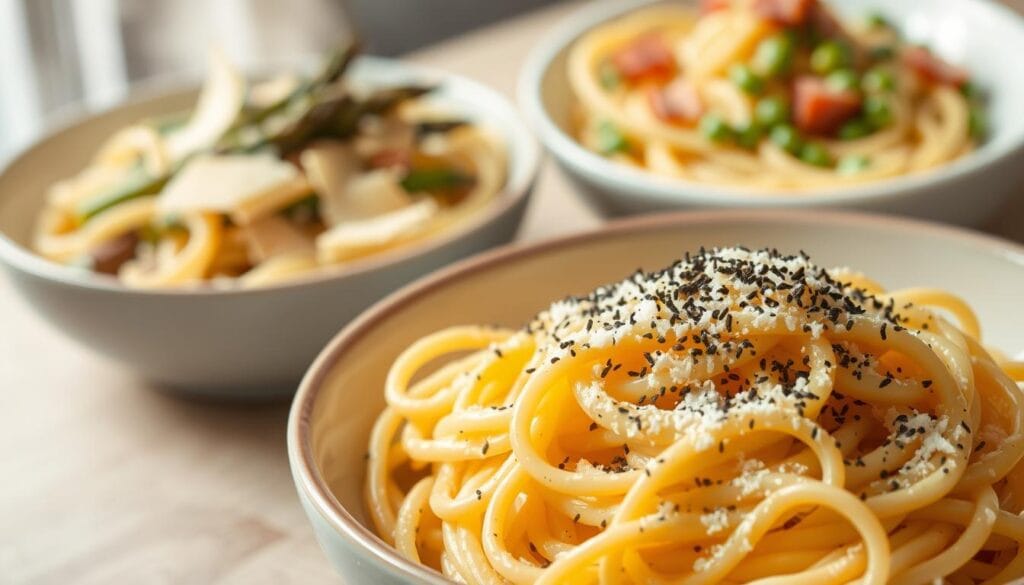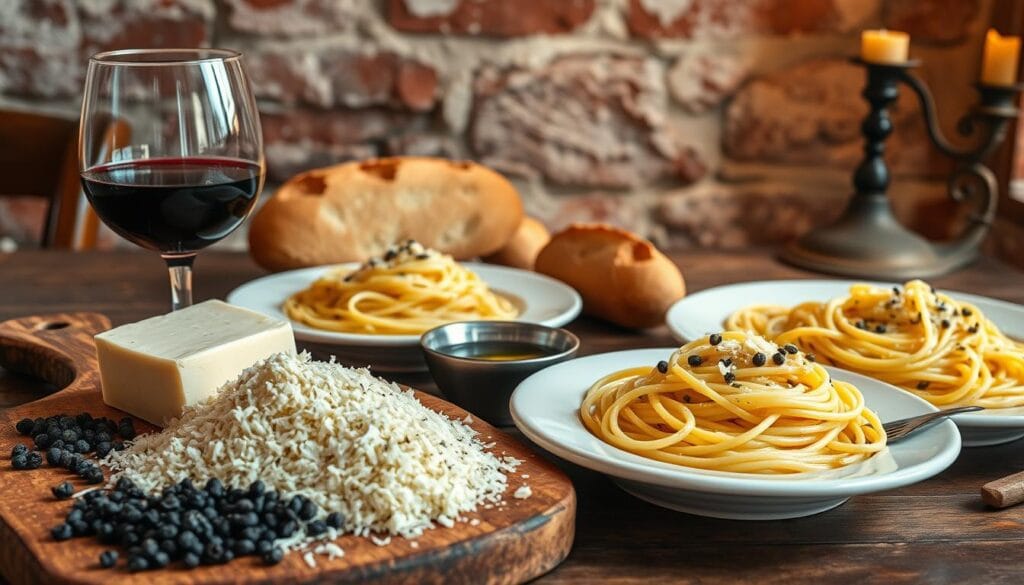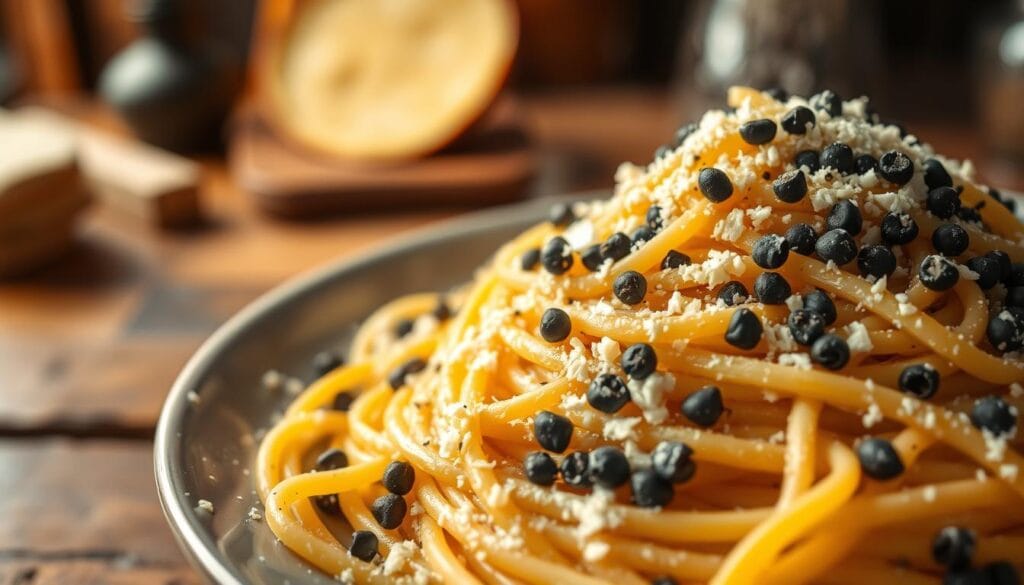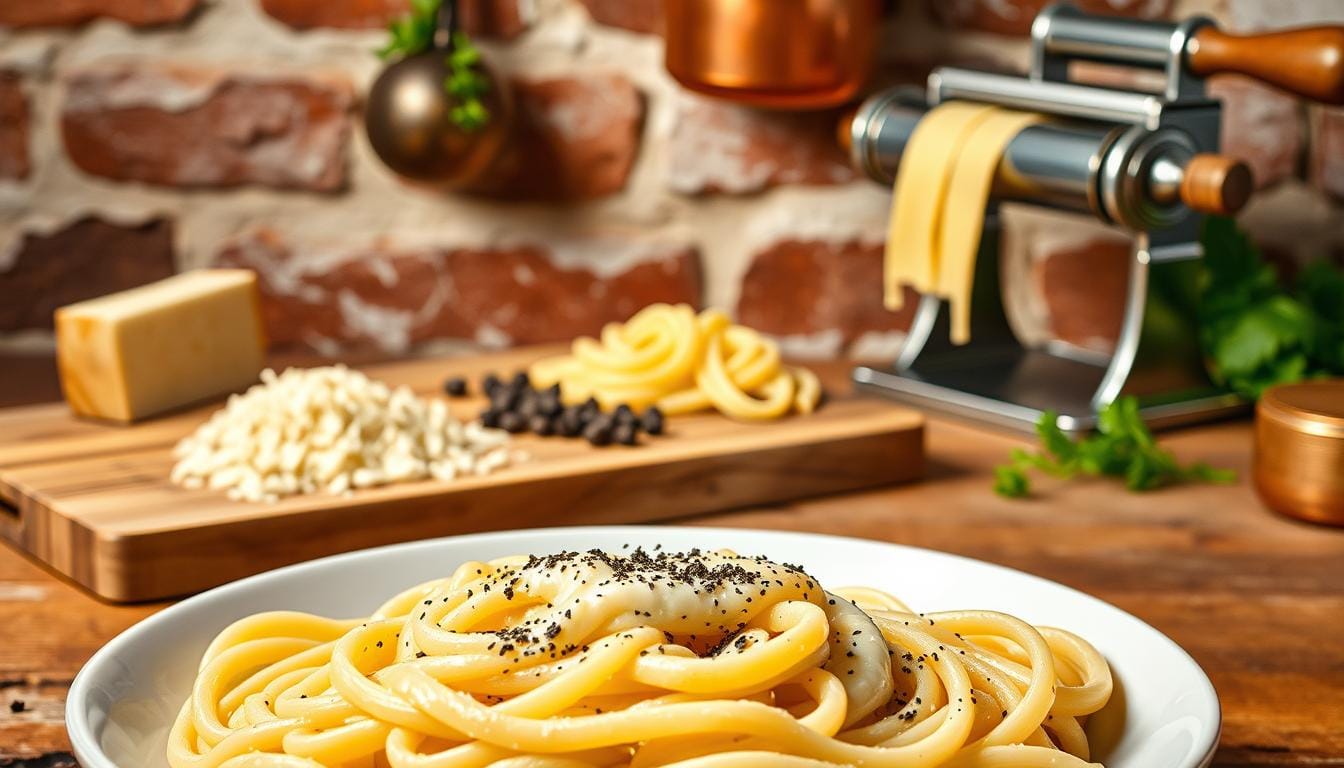Imagine walking into a bustling Roman trattoria. The smell of black pepper and melted Pecorino Romano fills the air. Cacio e Pepe, or “cheese and pepper,” is simple yet comforting.
As you twirl the pasta, each bite is not just filling. It also brings back memories of laughter and warmth. Now, you can make this authentic dish at home. It’s perfect for weeknight dinners or impressing guests.
Table of Contents
Key Takeaways
- Cacio e Pepe centers around just a few key ingredients: pasta, Pecorino Romano cheese, and black pepper.
- This authentic Cacio e Pepe recipe is quick to prepare, perfect for busy evenings.
- Making this easy Cacio e Pepe recipe allows you to enjoy restaurant-quality flavors at home.
- It’s a budget-friendly dish, requiring minimal groceries while delivering on taste.
- This classic Roman dish holds a rich history, deeply connected to Italian culinary traditions.
What is Cacio e Pepe?
Cacio e pepe is a famous dish from Rome, loved for its simple yet bold flavors. It’s made with just three main ingredients: pasta, Pecorino Romano cheese, and black pepper. The pasta water makes the cheese and pepper mix into a smooth, creamy sauce.
This dish comes from the simple meals of shepherds. It’s a true comfort food. With its focus on quality ingredients, every bite is a burst of flavor. It’s a classic dish that’s both traditional and quick to make.
Ingredients Needed for Your Cacio e Pepe Recipe
For a perfect cacio e pepe, the right ingredients are key. This dish is loved for its simple yet rich taste. Quality ingredients make your meal even better. Here’s what you need for a great dish:
Traditional Ingredients
- 8 ounces of dried bucatini or spaghetti
- ½ cup of freshly grated Pecorino Romano cheese
- ½ teaspoon of freshly cracked black pepper
- Optional: 2 tablespoons of unsalted butter for enhanced creaminess
Variations and Substitutions
Want to try something new? Mix Pecorino Romano with Parmigiano-Reggiano for a unique taste. For those who can’t eat gluten, try gluten-free pasta. It lets everyone enjoy this easy recipe.
You can also add proteins like sautéed shrimp or chicken. Adding veggies like peas or broccoli makes it a fuller meal.
Benefits of Making Homemade Cacio e Pepe
Making your own cacio e pepe is a great choice for families. It’s quick to make and needs just a few ingredients. This makes it a hit for many.
Quick Meal Solution
This recipe is ready in about 20 minutes. It’s perfect for busy nights when you want a tasty meal fast. You can turn simple items into a fancy dish, saving time.
Budget-Friendly Dinner Option
This dish is also easy on your wallet. The ingredients are cheap and common. Making it at home lets you enjoy a delicious meal without spending a lot.
| Ingredient | Cost per Serving |
|---|---|
| Pasta | $0.50 |
| Pecorino Romano Cheese | $1.00 |
| Black Pepper | $0.10 |
| Salt | $0.05 |
| Total Cost | $1.65 |
The cost of making this recipe is very low. So, you get a delicious meal that fits your budget and tastes.
How to Prepare Cacio e Pepe at Home
Making cacio e pepe at home is a fun and rewarding task. This recipe uses just a few ingredients, highlighting the rich flavors of cheese and pepper. Follow these simple steps to make a delicious cacio e pepe that will impress your family and friends.
Step-by-Step Cooking Instructions
- Start by boiling a large pot of salted water. Cook your pasta until it’s al dente, which usually takes 6 to 8 minutes.
- Before you drain the pasta, save about ⅔ cup of the pasta water.
- In a skillet, melt butter (if you’re using it) and add black pepper over medium heat. Let it cook for about 30 seconds until it smells great.
- Put the drained pasta into the skillet, along with some of the saved pasta water.
- Add the grated Pecorino Romano to the pasta. Toss it until the sauce is creamy and sticks to the pasta. If it’s too thick, add more pasta water.
- Finish by serving it hot, topped with extra Pecorino Romano and freshly cracked pepper for that extra touch.
Tips for the Best Cacio e Pepe Recipe
To make the perfect cacio e pepe, follow a few key steps. Using the right ingredients and techniques will make your dish stand out.
Avoiding Clumpy Cheese
It’s important to use freshly grated Pecorino Romano. Pre-packaged cheese can have additives that mess with melting. Grating your cheese ensures it melts smoothly and blends well with the pasta.
Choosing the Right Pasta
Choose long pasta like bucatini or spaghetti. These shapes help the sauce stick evenly. Keep some pasta water aside. It’s full of starch that prevents the cheese from clumping.
Classic Cacio e Pepe Variations
Make your best cacio e pepe recipe even better with different variations. These changes add flavor and texture. They also make the dish more interesting for everyone.
Additions for Extra Flavor
- Proteins: Try adding sautéed shrimp or grilled chicken for a fuller meal. These proteins mix well with the cheese and pepper.
- Vegetables: Add steamed peas or roasted veggies for freshness and nutrition. They add color and health to your dish.
- Seasonings: For a spicy touch, use crushed red pepper flakes. Or, try buttered breadcrumbs for a crunchy texture.

Common Mistakes to Avoid When Making Cacio e Pepe
Making a tasty cacio e pepe means knowing what to avoid. It’s about keeping your dish’s flavor and creamy texture right. Two big mistakes are not using enough pasta water and using pre-grated cheese.
Not Using Enough Pasta Water
Not saving enough pasta water is a common mistake. This starchy liquid is key to binding the cheese to the pasta. Always save at least ⅓ cup of pasta water before draining your noodles. Adding this water slowly can make your sauce creamier.
Using Pre-Grated Cheese
Another mistake is using pre-grated cheese. It’s easy to use, but it has additives that make your dish grainy. For the best melt and taste, use freshly grated cheese. This choice will make your cacio e pepe even better.
Pairing Options for Cacio e Pepe
Cacio e pepe is amazing on its own, but the right pairings make it even better. Choosing the perfect sides can really bring out the dish’s unique tastes.
Perfect Side Dishes
Looking for the best sides for cacio e pepe? Here are some great options:
- An arugula salad with lemon vinaigrette adds a nice tanginess.
- Roasted root vegetables add a hearty and flavorful touch.
- Garlic bread offers a crunchy texture and a rich taste.
Wine Pairings to Consider
Choosing the right wine can make your cacio e pepe meal complete. A light white wine, like Sauvignon Blanc, can brighten the flavors. Or, a light-bodied red like Chianti can enhance the dish without overpowering it.

Storing and Reheating Leftover Cacio e Pepe
Enjoying cacio e pepe the next day is just as good as when it’s fresh. The right storage and reheating techniques keep it creamy and flavorful. Follow these tips to make your leftovers taste great.
Best Practices for Storage
Put leftover cacio e pepe in an airtight container in your fridge. This keeps it fresh and prevents moisture. It’s best to eat it within three days for the best taste.
Reheating Tips
Reheating cacio e pepe needs a bit of care to avoid dryness. Here are some ways to do it:
- Stovetop: Warm it in a skillet on medium-low heat. Add a little pasta water to keep it creamy.
- Microwave: Use a microwave-safe dish with a bit of water. Stir often to heat evenly.
Why You Should Try This Authentic Cacio e Pepe Recipe
Making an authentic cacio e pepe recipe lets you dive into Italian cuisine’s heart. It’s a dish that shows the beauty of simplicity with just a few top-notch ingredients. You might ask, why try cacio e pepe? The answer is in its rich flavors and simple preparation.
By making your own cacio e pepe, you learn about traditional Roman cooking. Every step, from picking the right pasta to getting the cheese just right, adds to the dish’s harmony. Cooking it yourself is rewarding, as you’ll enjoy mastering a meal that has pleased people for ages.
The authentic cacio e pepe recipe is versatile, letting you add your own touch while keeping its classic feel. It’s not just a tasty dinner option but also a great conversation starter. When you make this iconic dish at home, your friends and family will be amazed.

Adding this dish to your cooking list makes meals easier without losing flavor. You might find that making cacio e pepe becomes a special tradition for meals or a cozy dinner alone. Let yourself explore this wonderful recipe and taste the real Italy in your own kitchen.
Conclusion
Cacio e pepe is a dish that perfectly combines simplicity with comfort. It’s a great choice for any occasion. This easy cacio e pepe recipe shows how a few quality ingredients can make a satisfying meal. It will impress your family and friends.
As you’ve learned, there are many ways to make your cacio e pepe special. You can try new flavors or avoid common mistakes. Whether it’s a casual weeknight dinner or a dinner party, this recipe will delight everyone.
Embracing Italian cuisine can be rewarding and delicious. Let this easy cacio e pepe recipe inspire you to try new things in the kitchen. With every bite, you’ll enjoy the rich traditions behind this dish. And you’ll love the process of making something special at home.

